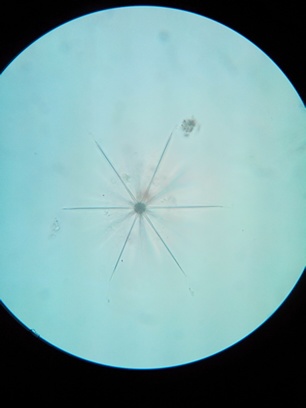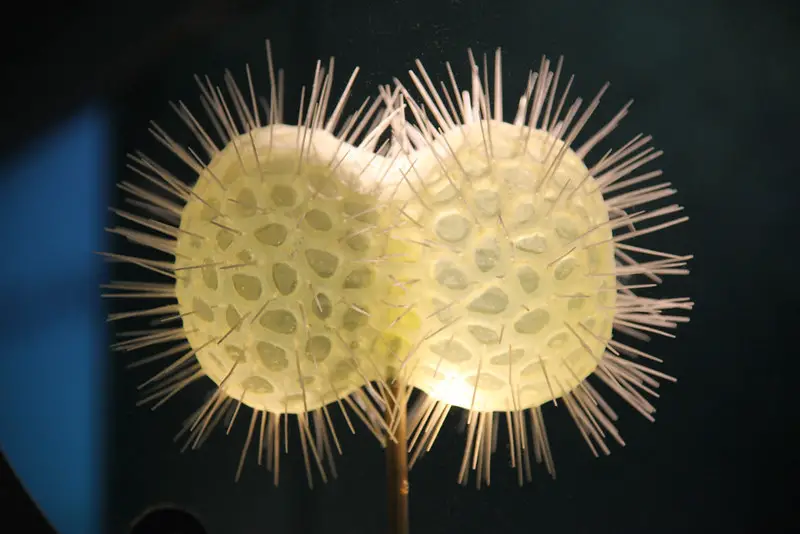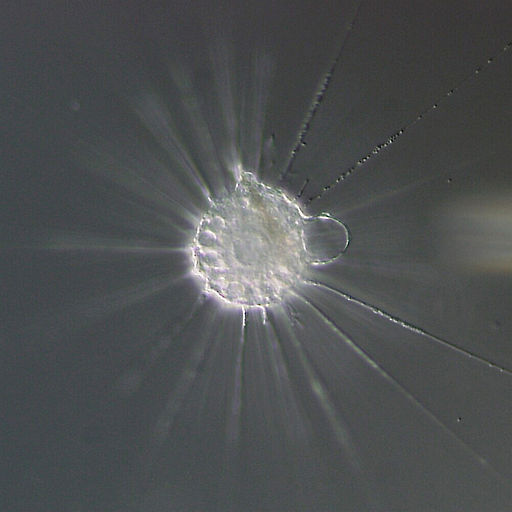Class Actinopoda
Definition, Examples, Characteristics and Classification
Definition: What is Actinopoda?
Class Actinopoda is under the subphylum Sarcodina and phylum Sarcomastigophora that consists of planktic marine organisms. However, some members of this group can be found in freshwater.
Like members of the class Foraminifera, the majority of actinopods are shelled protozoans which separates/distinguish them from other naked members of the phylum.
While some of the species are colonial (form agglomerations), the majority of Actinopods are solitary and thus occur as single cells that float freely in their habitat. In addition to the shell/fine skeleton, members of the class are also characterized by anastomosing pseudopodia (stiffened pseudopodia).
The class is further divided into several subclasses that include heliozoa, acantharia, and radiolaria.
* The name Actinopoda is derived from the Greek words "actinos" meaning ray and "pous" meaning foot.
Some members of the class Actinopoda include:
- Actinophrys pontica
- Hexaconthium asteracanthion
- Thalassicola pellucida
- Clathrulina elegans
- Sticholonche zanclea
Classification of class Actinopoda
(Based on Riedel (1967) proposal)
Kingdom: Protista - Consists of simple eukaryotes (protists) that either exist as single cells/solitary or in colonies. They are commonly found in aquatic environments or moist terrestrial habitats as free-living organisms. However, some of the species form a symbiotic relationship with other organisms while others exist as parasites.
Phylum: Sarcomastigophora - Consists of protists that can be found in colonies or singly in various aquatic habitats. They are characterized by such locomotory structures as pseudopodia or flagella (or both in some species). While some of the members in this group are autotrophic, many, like Actinopods are heterotrophic.
Subphylum: Sarcodina - Consisting of such organisms as Actinopods, Sarcodina is one of the largest groups under the kingdom Protista. The majority of species in this group can be found in various aquatic or moist environments where they move and capture food by means of pseudopods (streaming cytoplasm).
Class: Actinopoda - various characteristics of Actinopods will be discussed below in detail
Ecology
As mentioned, Actinopods are mostly found in marine environments (particularly Radiolarians and Acantharia) where they occur singly or in colonies. Radiolarians, for instance, have been identified in all world oceans with distribution and abundance being dependent on various biotic and abiotic factors.
The temperature range is one of the factors that has been shown to affect the abundance of these organisms in marine environments. For example, species commonly found at the North and South Poles have are also abundantly found at increasing ocean depths characterized by decreasing temperatures.
For different species, changes in temperature also has a direct impact on reproduction where increasing or decreasing temperature promote or decrease the rate of reproduction (Studies have revealed Radiolarian fauna to be lowest during the summer months).
Like Radiolarians, organisms classified under the subclass Acantharia are also commonly found in marine environments. Here, however, they are found at depths less than those in which Radiolarians are found and tend to be more susceptible to changes in environmental conditions (preferring the warm summer temperatures).
In the sea, they occur in high numbers among plankton particularly at depths of between 50 and 200 meters (primitive forms are commonly found at lower depths compared to more evolved forms).
Unlike members of the subclass Radiolaria and Acantharia, Heliozoans are commonly found in freshwater environments. Here, they are regarded as passive benthic predators that feed on various small prey. However, they can also exist as planktonic for a given period of time which contributes to their dispersal.
Morphological/structural characteristics of Actinopods
Radiolarians
Like many other protists, Radiolarians are unicellular organisms. However, some of the species form colonies. Although they are generally small in size, the single-celled species vary in size from about 50um to larger species that can grow to about 2mm in diameter.
Colonial species resemble clusters with numerous cells packed together. These cells are connected by a network of cytoplasmic strands in addition to being enclosed within a gelatinous envelope that is produced by the organisms.
Given that these colonies consist of numerous cells held together, they are larger in size and may range from a few centimeters to about 1 meter in length. Apart from the differences in size, these colonies also vary in shape. For instance, whereas some of the colonies may be spherical, others will form an ellipsoidal or ribbon-shape.
* Single-celled Radiolarians are mostly spherical in shape.
Based on microscopic studies, a number of organelles, characteristic of those found in eukaryotes, have been identified. These include a centrally located nucleus (membrane-bound), mitochondria, Golgi bodies, as well as the cytoplasm among others.
Like other Actinopods, Radiolarians are also characterized by skeletons formed through the deposition of inorganic material. The smaller species, according to studies, secrete siliceous skeletons of complex designs. These skeletons vary significantly and therefore serve as the basis of taxonomic identification.
The larger species have been shown to either lack a skeleton or consist of a gelatinous coat. In some of the species, the large species secrete siliceous spicules near the peripheral cytoplasm which surrounds the gelatinous layer.
The skeleton is also highly perforated which results in varying patterns between different species. The spike-like pseudopodia, which extends from the cell body, extend through the perforations and used for movement and feeding. While they also contribute to floating, this is the primary function of the many vacuoles located in the outer cytoplasm.
Heliozoans
Like other members of the class Actinopoda, Heliozoans are planktonic protozoa. However, they are commonly found in freshwater environments where they exist as micro and meiobenthos.
While the majority of these organisms are found in freshwater, some species have been detected in marine and brackish habitats. Despite the fact that some of these species are found in a different environment, they do not vary significantly with regards to morphology.
Morphologically, heliozoas are spherical in shape and range from 200um to 1mm in diameter. While they closely resemble Radiolarians, Heliozoans are distinct in that they lack the central capsule membrane located between the endo- and ectoplasm.
Depending on the species, their skeleton may consist of chitinous matter impregnated with silica or mucilage. Some have also been shown to consist of sand grains or diatom frustules. Their shells are also characterized by many pores through which the thread-like pseudopods (axopodia) extend. These are important structures that allow the organism to capture and ingest prey.
* The pseudopodia (axopodia) are stiffened by the presence of microtubules which act as the central axis.
A number of organelles and cellular structures have also been identified through microscopic techniques.
These include:
- Endoplasm consisting of numerous vacuoles - the vacuoles promote floating
- Mitochondria
- Ribonucleoprotein particles
- Endoplasmic reticulum - Rough and smooth
- Golgi complex
- Nuclei
Acantharia
Like other members of the class Actinopoda, Acantharia are unicellular eukaryotes. They range from 20 to 800um in size with a spherical body structure. Unlike the other groups, Acantharia are the only organisms known to change their morphology as they form cysts (involved in reproduction).
In their life cycle, flagellated cells known as swarmers are released when the cyst wall ruptures. However, they may also be released through the pores located on the cyst wall. Here, however, it's worth noting that not all the species in this group form reproductive cysts. As a result, the swarmers are produced by the adult form of the organism.
* Among Acantharia species, cysts are not necessarily the result of unfavorable environmental conditions.
During cyst formation, the spicules and various components of the cell are resorbed which distinguishes cysts from the adult forms. By losing these structures and organelles, the cysts lose their ability to float. They also start to accumulate a celestite shell that is between 5 and 7um in thickness.
As is the case with the shells found in the adult forms, these shells also vary in shape (from round and oval to elongated) with various species seemingly having different shapes. Differences have also been identified in the components of these shells where some of the species consist of mineral plates.
The internal structure of the cell is divided into the ectoplasm and endoplasm compartments that are divided by the periplasmic cortex as well as a capsular wall. Here, the ectoplasm makes up the cytoplasmic content of the cell that extends to form the pseudopodia. As such, it plays an important role in capturing prey.
In addition, it's also involved in buoyancy, promoting floating in water. The endoplasm, on the other hand, is commonly described as the true cytoplasm and consists of cell organelles (nuclei, mitochondria, and the Golgi complex, etc).
Nutrition
As heterotrophic organisms, Actinopods have to feed on various organisms in order to survive. Some of the most common prey for these organisms include bacteria, microalgae, and protozoa among others.
Using their pseudopods, they are able to trap and capture the prey which is then digested in the food vacuole. In Actinopods, the pseudopodia/axopodia are sticky which allows them to effectively trap and capture (and even paralyze) prey when they come in contact. The nutrients digested in the vacuoles are then passed to the endoplasm through the perforated central capsule.
* Larger Radiolarians have been shown to capture relatively larger prey such as copepods and planktonic crustaceans.
Apart from feeding on other organisms in their environment, some members of the class Actinopoda get their nutrition from a symbiotic relationship with algae. In water surface, for instance, studies have shown many Acantharian species to form a symbiotic relationship with microalgae. Here, the organisms harbor the algae in their cytoplasm.
Apart from algae, some of the species, e.g. some members of the subclass Radiolaria, for this relationship with photosynthetic bacteria (cyanobacteria). Through this relationship, Actinopods are suggested to play a role in primary production. This relationship is particularly beneficial for the organism given that they take up some of the carbon fixed by the symbiont.
* Depending on the species, Acantharia can host between 10 and 100 microalgal cells.
Reproduction
Based on a variety of studies, members of the class Actinopoda have been shown to use various modes of reproduction. These include binary fission and multiple fission, budding, and formation of flagellated spores.
Asexual reproduction by fission has been observed in a number of organisms including those that form colonies, species that lack a skeleton as well as species characterized by spicules. Some examples of species in which fission has been identified include Spumellaria and Phaeodaria.
During binary fission, studies have shown the colonies (spherical or spheroidal in shape) to become elongated as the gelatin constricts in a manner that produces a segmented cylindrical colony. Eventually, the segments separate at the point of constriction to form two daughter colonies.
During multiple fission, on the other hand, the process has been associated with a number of activities that include; branching of the central capsule and nucleus, dispersal of oil droplets, and pigments within the cytoplasm in the intracapsulum as well as the separation of the nucleoplasm into many distinct corpuscles, etc.
Eventually, the extracapsulum divides into numerous fragments with each of the fragments containing a number of nuclei that are covered by a layer of endoplasm. Asexual reproduction through budding has also been demonstrated in a number of colonial species include C. fulvum and Sphaerozoum neapolitanum.
Here, the buds, which are highly refractive, are attached to the jelly of the colony and are likely to become part of the colony.
* Although the mother/parent cell shares cytoplasm with the daughter cells during binary fission, only one of the cells inherits the skeleton. For this reason, the other cell has to build a new skeleton. However, this is not a requirement for reproduction to start (for the new daughter cell to reproduce/divide).
* During multiple fission, the organism(s) sheds the ectoplasm and start to sink.
Swarmers
Reproduction in some of the species, particularly members of the subclass Radiolaria, involves the production of flagellated swarmers. This mode of reproduction starts with multiple division of the nucleus (of the parent cell) which the mass of the cell gradually transforms into uninucleated flagellated swarmers.
While studies are ongoing, these swarmers are suspected of being gametes that fuse to form the zygote once they are released into the environment.
Cysts
Unlike many organisms that form cysts in order to survive adverse environmental conditions, Acantharia, a subclass of Actinopoda, produce cysts for reproduction. During their life cycle, the cells undergo morphological changes to form cysts in which numerous flagellated swarmers develop.
During cyst formation, the spicules and skeleton are first resorbed as a thick wall deposited around the cell. As the cysts sink from the surface, the swarmers are released at deeper water levels compared to where the adult forms reside.
As is the case with swarmers produced by Radiolarians, some of the Acantharia swarmers have been suggested to fuse and give rise to zygote that develops to produce juvenile Acantharia. Over time, these forms rise to the ocean surface where they mature and repeat the life cycle.
* Not all Acantharia species are capable of forming cysts.
Understanding Photosynthetic Bacteria
Return to Phylum Protozoa main page
Return from class Actinopoda to MicroscopeMaster home
References
Boltovskoy D., Anderson O.R., Correa N.M. (2017) Radiolaria and Phaeodaria. In: Archibald J. et al. (eds) Handbook of the Protists. Springer.
Claudia Castellani and Martin Edwards. (2017). Marine Plankton: A Practical Guide to Ecology, Methodology, and Taxonomy.
Elsa Massera Bottazzi. (2009). Systematic-ecological aspects of Radiolaria with
special reference to Acantharia.
George Karleskint, Richard Turner, and James Small. (2009). Introduction to Marine Biology.
Johan Decelle et al. (2013). Diversity, Ecology and Biogeochemistry of Cyst-Forming Acantharia (Radiolaria) in the Oceans.
Orvil Roger Anderson. (1983). Radiolaria.
Links
https://palaeo-electronica.org/content/1-2-recent-radiolaria-of-the-south-atlantic
https://photosymbiosis.com/about-the-acantharia/
Find out how to advertise on MicroscopeMaster!







